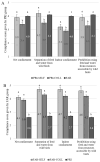How Do Flemish Laying Hen Farmers and Private Bird Keepers Comply with and Think about Measures to Control Avian Influenza?
- PMID: 39453067
- PMCID: PMC11512282
- DOI: 10.3390/vetsci11100475
How Do Flemish Laying Hen Farmers and Private Bird Keepers Comply with and Think about Measures to Control Avian Influenza?
Abstract
Competent authorities of many countries, including Belgium, impose control measures (preventing wild bird access to feeders and water facilities, indoor confinement of captive birds, or fencing off outdoor ranges with nets) on professional and non-professional keepers of birds to prevent the spread of avian influenza (AI). Flemish laying hen farmers (FAR, n = 33) and private keepers of captive birds (PRI, n = 263) were surveyed about their opinion on and compliance with AI measures legally imposed during the most recent high-risk period before this survey in 2021. Participants answered questions on a 5-point Likert scale (1 = the worst, 3 = neutral, and 5 = the best). FAR indicated better compliance with the AI measures than PRI, except for net confinement. FAR indicated that they and other poultry farmers complied better with AI measures than PRI. Additionally, PRI indicated that they better complied than other PRI keepers. FAR regarded the AI measures as more effective than PRI. To prevent the spread of AI more effectively, national authorities could focus on information campaigns explaining to private bird keepers the need for the various control measures that they impose. If these campaigns fail, local authorities may need stricter enforcement or alternative ways to increase compliance.
Keywords: avian influenza; confinement; nets; poultry; self-evaluation.
Conflict of interest statement
The authors declare no conflicts of interest.
Figures



Similar articles
-
UK flockdown: A survey of smallscale poultry keepers and their understanding of governmental guidance on highly pathogenic avian influenza (HPAI).Prev Vet Med. 2024 Mar;224:106117. doi: 10.1016/j.prevetmed.2024.106117. Epub 2024 Jan 20. Prev Vet Med. 2024. PMID: 38277819
-
Antimicrobials usage assessments in commercial poultry and local birds in North-central Nigeria: Associated pathways and factors for resistance emergence and spread.Prev Vet Med. 2018 Jun 1;154:139-147. doi: 10.1016/j.prevetmed.2018.04.001. Epub 2018 Apr 5. Prev Vet Med. 2018. PMID: 29685438
-
Epidemiological risk factors of knowledge and preventive practice regarding avian influenza among poultry farmers and live bird traders in Ikorodu, Lagos State, Nigeria.Int J Vet Sci Med. 2017 Apr 29;5(1):47-52. doi: 10.1016/j.ijvsm.2017.03.002. eCollection 2017 Jun. Int J Vet Sci Med. 2017. PMID: 30255048 Free PMC article.
-
An overview of the epidemiology of avian influenza.Vaccine. 2007 Jul 26;25(30):5637-44. doi: 10.1016/j.vaccine.2006.10.051. Epub 2006 Nov 9. Vaccine. 2007. PMID: 17126960 Review.
-
Avian Influenza: Strategies to Manage an Outbreak.Pathogens. 2023 Apr 17;12(4):610. doi: 10.3390/pathogens12040610. Pathogens. 2023. PMID: 37111496 Free PMC article. Review.
Cited by
-
Preparedness, prevention and control related to zoonotic avian influenza.EFSA J. 2025 Jan 29;23(1):e9191. doi: 10.2903/j.efsa.2025.9191. eCollection 2025 Jan. EFSA J. 2025. PMID: 39882189 Free PMC article.
References
LinkOut - more resources
Full Text Sources

